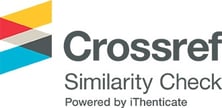Pengaruh Blended Learning, Jigsaw, Direct Instruction Terhadap Pemahaman Akuntansi Pada Matakuliah Teori Akuntansi
DOI:
10.33395/owner.v7i3.1609Keywords:
Blended Learning, Direct Instruction, Jigsaw, Pemahaman AkuntansiAbstract
This research aims to examine differences in students' understanding of accounting taught with Blended Learning, Jigsaw, and Direct Instruction learning models. The research was conducted at the University of ABC. The study population numbered 264 students, then the sampling technique used cluster random sampling, and the number of students being sampled was 60. This type of research is quasi-experimental. Data collection techniques using learning outcomes tests. The data analysis technique used one ANOVA. The results showed (1) There was a significant difference in the understanding of accounting taught by the Blended Learning model, Jigsaw, and Direct Instruction, (2) Students who were taught with Blended Learning had a significantly higher understanding of accounting than students taught with Jigsaw, (3) Students who were taught with Blended Learning had a higher understanding of accounting than students who were taught with Direct Instruction, (4) Students who were taught with Jigsaw had a lower understanding of accounting than students who were taught with Direct Instruction. In conclusion, Blended Learning, Jigsaw, and Direct Instruction learning models positively affect understanding accounting. The most effective learning model in this research was Blended Learning. Blended Learning, Jigsaw, and Direct Instruction learning models can be used to teach accounting; however, to maximize the effect of Blended Learning, Blended Learning requires a powerful internet connection.
Downloads
Plum-X Analityc
References
Anderson, L. W., Krathwohl, D. R., & Bloom, B. S. (2001). Revised Bloom’s Taxonomy. In A Taxonomy for Learning, Teaching, and Assessing: A Revision of Bloom’s Taxonomy of Educational Objectives.
Banyen, W., Viriyavejakul, C., & Ratanaolarn, T. (2016). A Blended Learning Model For Learning Achievement Enhancement Of Thai Undergraduate Students. International Journal of Emerging Technologies in Learning, 11(4), 48–55. https://doi.org/10.3991/ijet.v11i04.5325
Cohen, L., Manion, L., & Morrison, K. (2007). Research Methods In Education. Taylor & Francis Group.
Direktorat Jenderal Pembelajaran Dan Kemahasiswaan. (2019). Proses Pembelajaran Daring SPADA 2019.
Permindikbud No. 109 Tahun 2013 Tentang Penyelenggaran Pendidikan Jarak Jauh Pada Pendidikan Tinggi, (2019). https://lppmp.uns.ac.id/wp-content/uploads/2018/03/Permen-Nomor-109-tahun-2013-ttg-PJJ.pdf
Jariyah, I. A., & Munfadlila, A. W. (2018). the Effect of Cooperative Learning Jigsaw Type To Increase Learning Result of Basic Biomedical Lecture. International Journal of Nursing and Midwifery Science (Ijnms), 2(02), 145–149. https://doi.org/10.29082/ijnms/2018/vol2/iss02/134
Jihad, T., Klementowicz, E., Gryczka, P., Sharrock, C., Maxfield, M., Lee, Y., & Montclare, J. K. (2018). Perspectives On Blended Learning Through The On-line Platform, Lablessons, For Chemistry. Journal of Technology and Science Education, 8(1), 34–44. https://doi.org/10.3926/jotse.312
Kade, A., Degeng, I. N. S., & Ali, M. N. (2019). Effect Of Jigsaw Strategy And Learning Style To Conceptual Understanding On Senior High School Students. International Journal of Emerging Technologies in Learning, 14(19), 4–15. https://doi.org/10.3991/ijet.v14i19.11592
Orhan, F. (2008). Redesigning A Course For Blended Learning Environment. Turkish Online Journal of Distance Education, 9(1), 54–66. https://doi.org/10.17718/tojde.64920
Pereira, J., Araújo, R., Farias, C., Bessa, C., & Mesquita, I. (2016). Sport Education And Direct Instruction Units: Comparison Of Student Knowledge Development In Athletics. Journal of Sports Science and Medicine, 15(4), 569–577.
Suendarti, M. (2017). The Influence of Jigsaw Learning Model on the Ability of Resolution Natural Science of Middle East Junior High School Students Indonesia. International Journal of Environmental & Science Education, 12(7), 1617–1622. http://www.ijese.net/makale/1927
Susetyo, B. (2015). Prosedur Penyusunan Dan Analisis Tes Untuk Penilaian Hasil Belajar Bidang Kognitif. PT Refika Aditama.
Wright, B. M. (2017). Blended Learnings Student Perception Of Face-To-Face And Online EFL Lessons. Indonesian Journal of Applied Linguistics, 7(1), 64–71. https://doi.org/10.17509/ijal.v7i1.6859
Yusoff, S., Yusoff, R., & Md Noh, N. H. (2017). Blended Learning Approach For Less Proficient Students. SAGE Open, 7(3), 1–8. https://doi.org/10.1177/2158244017723051
Zhou, M., & Brown, D. (2017). Educational Learning Theory. In Instructional Design: International Perspectives I. https://doi.org/10.4324/9780203062920-11
Downloads
Published
How to Cite
Issue
Section
License
Copyright (c) 2023 Anggono, Wenny Anggeresia Ginting, Sauh Hwee Teng , Sukiman , Tarwiyah

This work is licensed under a Creative Commons Attribution-NonCommercial 4.0 International License.

















